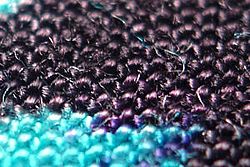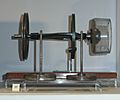Synthetic fabric facts for kids
Have you ever worn clothes made of nylon or polyester? These are examples of synthetic fabrics. They are special materials made by people in factories, not found naturally. We also call them "man-made" or "artificial" fabrics. They are created using clever chemical processes.
Contents
Synthetic Fabrics: What Are They?
Synthetic fabrics are different from natural ones like cotton or wool. They are made from chemicals that are put together in a specific way. This process creates long chains of tiny building blocks. Think of it like linking many small LEGO bricks to make a very long chain.
How Are Synthetic Fabrics Made?
Making synthetic fabrics involves a process called polymerization.
- First, scientists start with very small chemical units called monomers.
- Then, they join these monomers together, one by one.
- This joining creates long, strong chains called polymers.
- These polymers are the basic material for synthetic fibers.
- The fibers are then spun into threads, which are woven or knitted into fabric.
A Brief History of Synthetic Fabrics
People have been trying to create artificial fibers for a long time.
- In 1884, Joseph Swan made one of the first artificial fibers. He was trying to make a better light bulb filament.
- This early fiber was similar to rayon, which is made from wood pulp.
- Later, in the 1930s, a scientist named Wallace Carothers at a company called DuPont made a big breakthrough.
- He created nylon, the first truly synthetic fiber made entirely from chemicals.
- Nylon quickly became popular for things like stockings and parachutes.
Common Types of Synthetic Fabrics
There are many different kinds of synthetic fabrics, each with its own special uses.
- Nylon: This fabric is very strong and stretchy. It's used for swimwear, activewear, ropes, and even carpets.
- Polyester: Polyester is known for being wrinkle-resistant and durable. You'll find it in clothing, blankets, and upholstery.
- Rayon: While made by people, rayon comes from natural materials like wood pulp. It feels soft, like silk or cotton. It's used for clothing and linings.
- Polyvinyl Chloride (PVC): This is a type of plastic that can be made into a fabric-like material. It's often used for raincoats, bags, and waterproof items.
Why Are Synthetic Fabrics Important?
Synthetic fabrics offer many benefits that natural fabrics might not.
- They can be made to be very strong and last a long time.
- Many are resistant to water, stains, and wrinkles.
- They can be produced in large amounts, making them more affordable.
- Scientists can design them for specific purposes, like making sportswear that wicks away sweat.
- These fabrics are used in everything from clothes and shoes to tents and car parts.
Images for kids
-
Joseph Swan created the first synthetic fiber.
-
Nylon was first synthesized by Wallace Carothers at DuPont.
See also
 In Spanish: Fibra sintética para niños
In Spanish: Fibra sintética para niños





